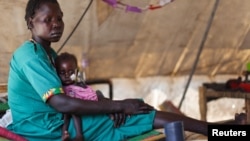DAKAR —
The World Health Organization says that children suffering from severe acute malnutrition can now be treated at home using specially formulated foods and antibiotics, as opposed to being hospitalized.
Nearly 20 million children under the age of five suffer from severe acute malnutrition, according to WHO. The majority of these children live in Africa and Southeast Asia.
The WHO says that, worldwide, malnutrition is a significant factor in more than a third of all deaths of children under the age of five. To help reduce these numbers, the WHO issued updated treatment guidelines on Tuesday for managing severe acute malnutrition in infants and children.
Zita Weise Prinzo is a technical officer in the WHO’s Department of Nutrition for Health and Development and co-coordinator of the report. She said that one of the changes to the 1999 guidelines is that children with severe acute malnutrition now have the possibility of being treated in their own homes.
"What we are now recommending, is that when a child has been identified as being severely acutely malnourished, if a child has appetite, does not have any complications linked to its medical status, this child does not need admitting in a hospital setting, where it could acquire other infections," Prinzo said. "The costs are high in hospitals, as well as the problem of a caretaker not being able to stay with the child in a hospital setting. So there’s no added advantage of such a child being admitted to a hospital. "
Prinzo said such outpatient care does not mean the child will not have contact with a health care facility. Rather, doctors will work closely with families to help them administer specially fortified foods and antibiotics and provide periodic follow-up care.
The WHO is also now recommending that children with severe acute malnutrition be tested and, if necessary, treated for HIV.
"In the past, this was not recommended because there was not enough knowledge about treating severe acute malnutrition, or even children who have HIV, with the available drugs at that time," she said. " But children with severe acute malnutrition should be treated to improve survival rates as well. "
Other updated guidelines include criteria for identifying children at risk of severe acute malnutrition before they develop serious health complications, including vitamin A supplements in treatment regimes, rehydration techniques and specific treatment recommendations for infants under the age of six months.
Prinzo said that if these guidelines are properly implemented at the country level, the chance of survival for children with severe acute malnutrition will be greatly improved.
She said, however, in many developing countries resources and manpower for implementing the recommendations remain limited.
Nearly 20 million children under the age of five suffer from severe acute malnutrition, according to WHO. The majority of these children live in Africa and Southeast Asia.
The WHO says that, worldwide, malnutrition is a significant factor in more than a third of all deaths of children under the age of five. To help reduce these numbers, the WHO issued updated treatment guidelines on Tuesday for managing severe acute malnutrition in infants and children.
Zita Weise Prinzo is a technical officer in the WHO’s Department of Nutrition for Health and Development and co-coordinator of the report. She said that one of the changes to the 1999 guidelines is that children with severe acute malnutrition now have the possibility of being treated in their own homes.
"What we are now recommending, is that when a child has been identified as being severely acutely malnourished, if a child has appetite, does not have any complications linked to its medical status, this child does not need admitting in a hospital setting, where it could acquire other infections," Prinzo said. "The costs are high in hospitals, as well as the problem of a caretaker not being able to stay with the child in a hospital setting. So there’s no added advantage of such a child being admitted to a hospital. "
Prinzo said such outpatient care does not mean the child will not have contact with a health care facility. Rather, doctors will work closely with families to help them administer specially fortified foods and antibiotics and provide periodic follow-up care.
The WHO is also now recommending that children with severe acute malnutrition be tested and, if necessary, treated for HIV.
"In the past, this was not recommended because there was not enough knowledge about treating severe acute malnutrition, or even children who have HIV, with the available drugs at that time," she said. " But children with severe acute malnutrition should be treated to improve survival rates as well. "
Other updated guidelines include criteria for identifying children at risk of severe acute malnutrition before they develop serious health complications, including vitamin A supplements in treatment regimes, rehydration techniques and specific treatment recommendations for infants under the age of six months.
Prinzo said that if these guidelines are properly implemented at the country level, the chance of survival for children with severe acute malnutrition will be greatly improved.
She said, however, in many developing countries resources and manpower for implementing the recommendations remain limited.










